The project of personal aircraft Bell Pogo
Since the early sixties, NASA staff have worked on a host of projects as part of the lunar program. In the foreseeable future, American astronauts were to land on the moon, which required a large number of special equipment for various purposes. Among other things, astronauts needed some means of transportation, with the help of which they could move across the surface of the Earth satellite. As a result, several LRV electric vehicles were delivered to the moon, but other transport options were considered at the early stages of the program.
At the preliminary proposal stage, NASA specialists considered various options for moving across the moon, including with the help of aircraft. They probably knew about Bell's projects, and they turned to her for help. The subject of the order was a promising personal aircraft that could be used by astronauts in the conditions of the moon. Thus, U. Moore and his team had to use the available technologies and developments, and also take into account the features of the satellite's gravity, the design of spacesuits, and other specific factors. In particular, the design of the spacesuits available at that time forced the engineers to abandon the proven “jetpack” layout.
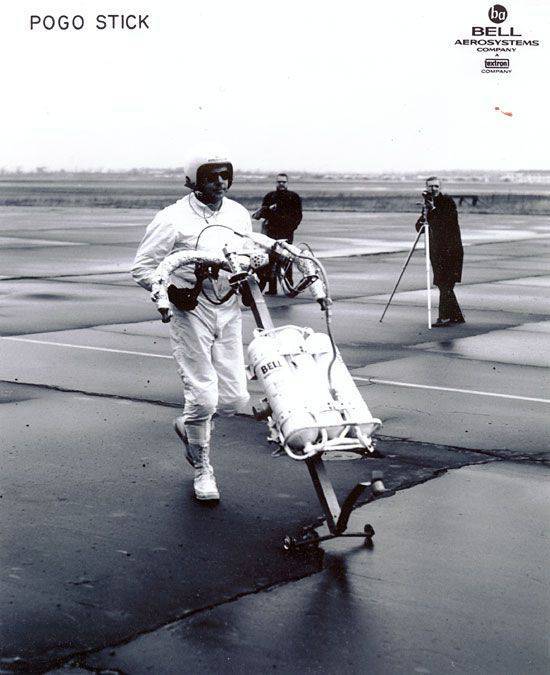
Robert Coater and the first version of the product Pogo
The project of the "lunar" aircraft was named Pogo - by the name of the toy Pogo stick, also known as "Grasshopper". Indeed, some versions of this product looked very much like a child's “vehicle”, although they had a number of characteristic features directly related to the technologies and technical solutions used.
For the third time, the Wendell Moore team decided to use proven ideas, which implied the use of a jet engine on hydrogen peroxide. For all its simplicity, this power plant provided the required traction and allowed to fly for some time. These engines had some drawbacks, but there were some reasons to believe that they would be less noticeable on the surface of the Moon than on Earth.
During the Bell Pogo project, three aircraft variants were developed for the lunar mission. They were based on the same principles and had a high degree of unification, since the same components were used in their design. However, there were some differences in layout. In addition, options with different payloads were proposed: some versions of the “Pogo” could only carry one person, while others had space for two pilots.
The first version of the Bell Pogo product was a redesigned version of the Rocket Belt or Rocket Chair, with major changes to the overall layout. Instead of a corset pack or a chair with a frame, it was proposed to use a metal rack with fixtures for all the main units. With the help of such a unit it was planned to ensure ease of use of the device in a heavy and not very comfortable spacesuit, as well as optimize the balancing of the entire product.
Below to the base rack fastened detail, which served as a step for the pilot and the base of the chassis. This time the pilot had to stand on the power element of the apparatus, which allowed him to get rid of the complex system of safety belts, leaving only a few necessary. In addition, on the sides of the steps there were mounts for small wheels. With their help, it was possible to transport the device from place to place. A small beam with an emphasis was provided on the front of the frame. With the help of wheels and an emphasis the device could stand vertically without support.
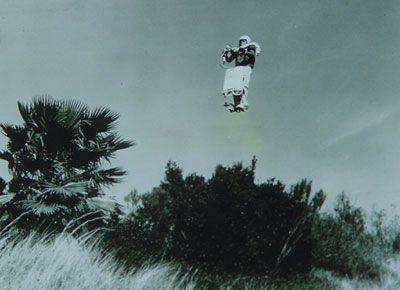
The device is in flight. Behind the Levers - R. Courter
In the central part of the rack was mounted a unit with three cylinders for compressed gas and fuel. As with the previous Bell equipment, the central cylinder served as a storage facility for compressed nitrogen, and the side tanks should be filled with hydrogen peroxide. Between themselves the cylinders were connected by a system of hoses, taps and regulators. In addition, they depart from the hoses leading to the engine.
The engine of the "classic" design offered to mount on the top of the rack using a hinge, which allows to control the thrust vector. Engine design remains the same. In its central part there was a gas generator, which was a cylinder with a catalyst device. The latter consisted of silver plates coated with samarium nitrate. Such a gas generator device made it possible to obtain energy from the fuel without the use of an oxidizer or combustion.
On the sides of the gas generator were attached two curved pipe with nozzles at the ends. In order to avoid heat loss and premature cooling of reactive gases, the pipelines were equipped with thermal insulation. The control tubes were attached to the engine control with small handles at the ends.
The principle of operation of the engine remained the same. Compressed nitrogen from the central cylinder was supposed to displace hydrogen peroxide from its tanks. Getting on the catalyst, the fuel had to decompose with the formation of a high-temperature gas-vapor mixture. Seven with temperatures up to 730-740 ° C had to go through the nozzles, forming jet thrust. The device should be controlled with the help of two levers and handles installed on them. The levers themselves were responsible for tilting the engine and changing the thrust vectoring. The arms were associated with mechanisms for changing thrust and fine adjustment of its vector. There is also a timer that warned the pilot about fuel production.
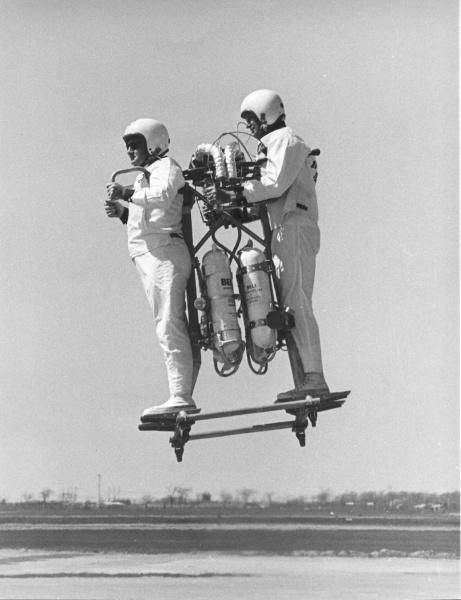
Double option "Pogo" in flight under the control of Gordon Yeager. Passenger - Technician Bill Burns
During the flight, the pilot had to stand on the steps and hold on to the controls. The engine was at the level of his chest, and the nozzles were located on the sides of the hands. Due to the high temperature of the reactive gases and the large noise produced by such an engine, the pilot needed special protection. His equipment consisted of a soundproof helmet with a timer buzzer, glasses, gloves, heat-resistant overalls and appropriate shoes. All this allowed the pilot to work, not paying attention to a cloud of dust during takeoff, engine noise and other adverse factors.
According to some data, the design of the Bell Pogo product used slightly modified units of the "Missile chair", in particular, a similar fuel system. Due to a slightly lower weight of the design, the engine thrust at the level of 500 pounds (about 225 kgf) allowed a slight increase in the characteristics of the device. In addition, the product "Pogo" was intended for use on the moon. Thus, not differing in high characteristics on the Earth, the perspective aircraft could be useful on the Moon, in the conditions of low gravity.
Design work on the first version of the project Bell Pogo ended in the mid-sixties. Using the available components, the team of W. Moore manufactured an experimental version of the apparatus and proceeded to its testing. The test pilot team remained the same. The verification of the prospective personal aircraft was carried out by Robert Kourter, William Sutor and others. Also, the general approach to inspections has not changed. First, the device flew on a leash in the hangar, and then began free flights in an open area.
As expected, the Pogo was not distinguished by high flight performance. He could climb to a height of no more than 8-10 m and fly at speeds of up to several kilometers per hour. The supply of fuel was enough for 25-30 seconds of flight. Thus, in terrestrial conditions, the new development of the Moore team differed little from the previous ones. However, with low gravity of the moon, the available parameters of thrust and fuel consumption allowed us to hope for a noticeable increase in flight data.
Soon after the first version of the Bell Pogo apparatus, a second one appeared. In this version of the project, it was proposed to increase the payload, making it possible to transport the pilot and passenger. It was suggested to do this in the simplest way: by “doubling” the power plant. Thus, to create a new aircraft, all that was needed was to develop a frame for fastening all the main elements. The engine and fuel system remained the same.
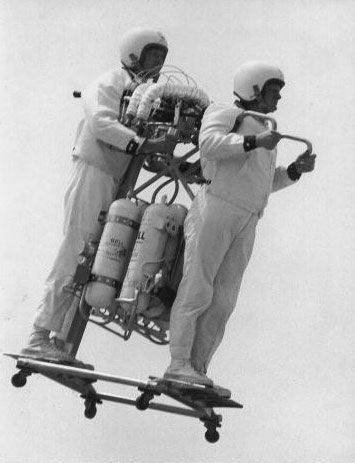
Yeager and Burns in flight
The main element of the two-seat apparatus was a frame of simple design. At the bottom of such a product there was a rectangular frame with small wheels, as well as two steps for the crew. In addition, on the frame were attached to the pillars of the power plant, connected at the top of the jumper. Between the racks were fixed two fuel systems of three cylinders each and two engines assembled in one unit.
The control system remained the same, its main elements were levers rigidly connected with swaying engines. The levers were brought forward to the pilot's seat. At the same time, they had a curved shape for optimal relative position of the pilot and handles.
During the flight, the pilot had to stand on the front footboard, facing forward. The control levers were held under his arms and flexed, providing access to the controls. Due to their shape, the levers were also an additional element of security: they kept the pilot and did not let him fall. The passenger was asked to stand on the back footboard. Passenger seat was equipped with two beams, held under his hands. In addition, he had to hold on to special handles located near the engines.
From the point of view of system operation and flight control, the double Bell Pogo version was no different from the single one. By starting the engine, the pilot could adjust the thrust and its vector, producing the necessary maneuvers in height and course. Due to the use of two engines and two fuel systems, it was possible to compensate for the increase in the weight of the structure and the payload, while maintaining the basic parameters at the same level.
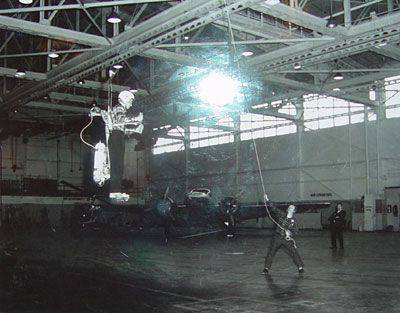
William "Bill" Sutor is testing a third version of the apparatus. The first flights are carried out using a safety rope.
Despite some complication of the design, the first two-seater aircraft, created by the team of W. Moore, had notable advantages over its predecessors. The use of such systems in practice made it possible to transport two people at once without a proportional increase in the weight of the aircraft. In other words, one double unit was smaller and lighter than two single, providing the same opportunities for the transport of people. Probably, the double version of the Pogo product could be of the greatest interest to NASA in terms of use in the lunar program.
Verification of the two-seater Pogo apparatus was carried out according to the already established scheme. At first he was checked in a hangar using safety cables, after which tests began in free flight. Being a further development of the existing design, the double unit showed good characteristics, which allowed to count on the successful solution of the assigned tasks.
In total, the Bell Pogo program has developed three versions of aircraft with the greatest possible unification. The third option was single and was based on the design of the first, although it had some noticeable differences. The main thing is the mutual placement of the pilot and the fuel system. In the case of the third project, the engine and cylinders should be located behind the pilot's back. The rest of the layout of the two devices did not differ much.
The pilot of the third variant of “Pogo” was supposed to stand on a footboard equipped with wheels and rest his back on the main rack of the vehicle. In this case, the engine was behind him at shoulder level. Due to changes in the overall layout, the management system had to be redone. The levers associated with the engine were pulled toward the pilot. In addition, for obvious reasons, they were lengthened. The rest of the principles of management remained the same.
The tests carried out according to the standard method again showed all the pros and cons of the new project. The flight duration still left much to be desired, however, the speed and altitude of the vehicle was quite sufficient for solving the tasks. It was also necessary to take into account the difference in gravity on the Earth and on the Moon, which made it possible to expect a noticeable increase in characteristics in terms of real use on the satellite.
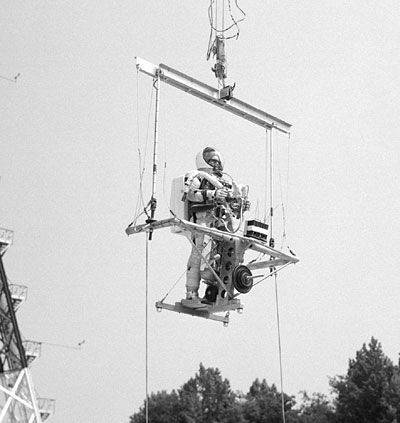
Tests with the participation of the astronaut and using the spacesuit. 15 June 1967
It can be assumed that the third variant of the Bell Pogo system was more convenient than the first in terms of management. This may indicate a different design of control systems with an increased lever arm. Thus, in order to exercise control, the pilot had to make less effort. Nevertheless, it should be noted that the layout of the third version of the device seriously hampered or even made it impossible for a person to use it in a spacesuit.
The development and testing of three variants of the Pogo apparatus has ended by the year 1967. This technique was presented to customers from NASA, after which collaborations started. It is known about the conduct of training events, during which astronauts, dressed in full-fledged space suits, mastered the management of personal aircraft of a new type. In this case, all such ascents in the air were carried out on a leash using a special suspension system. Due to the layout of space suits and aircraft, Pogo systems of the first type were used.
Collaborations of Bell Aerosystems and NASA lasted for some time, but did not give real results. Even taking into account the expected growth of characteristics, the proposed aircraft could not fulfill the requirements related to their intended use in the lunar program. Personal aircraft did not look like a convenient vehicle for astronauts.
For this reason, the Bell Pogo program was closed in 1968. NASA experts analyzed various proposals, including Bell's projects, after which they came to disappointing conclusions. The proposed systems did not meet the requirements of the lunar missions. As a result, it was decided to abandon attempts to fly over the surface of the moon and begin developing another vehicle.
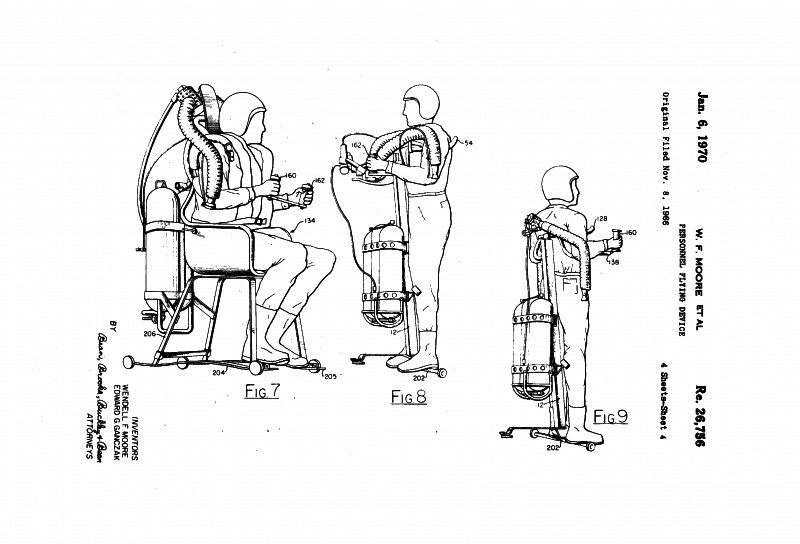
Figures from the US RE26756 E patent. Fig 7 - Rocket Chair. Fig 8 and Fig 9 - Pogo devices of the first and third versions, respectively
The vehicle development program for lunar expeditions ended with the creation of the LRV electric vehicle. 26 July 1971, the Apollo 15 ship went to the Moon, carrying such a machine. In the future, this technique was used by the crews of the Apollo-16 and Apollo-17 ships. During the three expeditions, astronauts drove around 90,2 km on these electric vehicles, spending 10 hours 54 on this.
As for the Bell Pogo devices, after the completion of the joint tests, they were sent to the warehouse as useless. In September 1968, Wendell Moore applied for a patent for a promising individual vehicle. It described the earlier project of the Rocket Chair, as well as two versions of the single-seat Pogo. By submitting an application, Moore received a patent for the number US RE26756 E.
The Pogo project turned out to be the latest development of Bell Aerosystems in the field of jetpacks and other similar equipment. For several years, the company's specialists have developed three projects, during which there appeared five different aircraft based on common ideas and technical solutions. During the work on the projects, the engineers studied various features of such equipment and found the best options for its design. However, further testing projects have not progressed. Created by Moore and his team of equipment did not meet the requirements of potential customers.
By the end of the sixties, Bell had completed all work on what seemed to be a promising and promising program and did not return to the subject of small-sized personal aircraft: jetpacks, etc. Soon all the documentation on the implemented projects was sold to other organizations, which continued their development. The result was the emergence of new, refined projects, and even small-scale production of some jetpacks. For obvious reasons, this technique has not received much distribution and did not get to the army or space.
On the materials of the sites:
http://rocketbelts.americanrocketman.com/
http://thunderman.net/
http://stevelehto.kinja.com/
http://warisboring.com/
Patent US RE26756 E:
http://google.com/patents/USRE26756
- Ryabov Kirill
- Rocketbelts.americanrocketman.com, Thunderman.net
Information